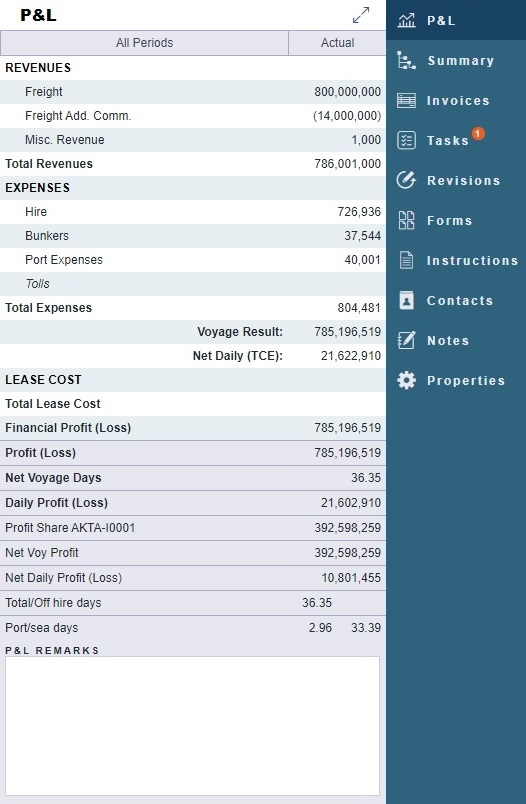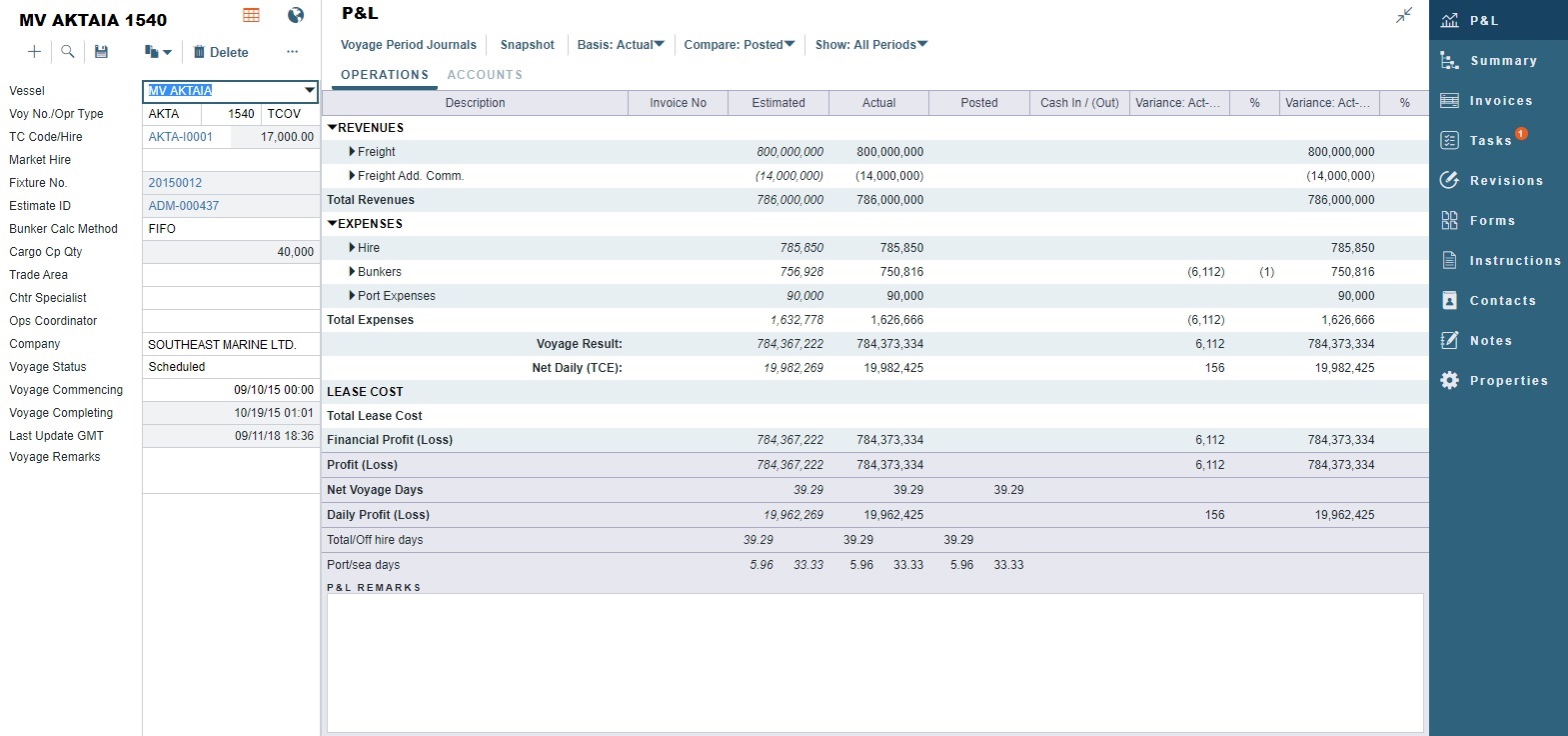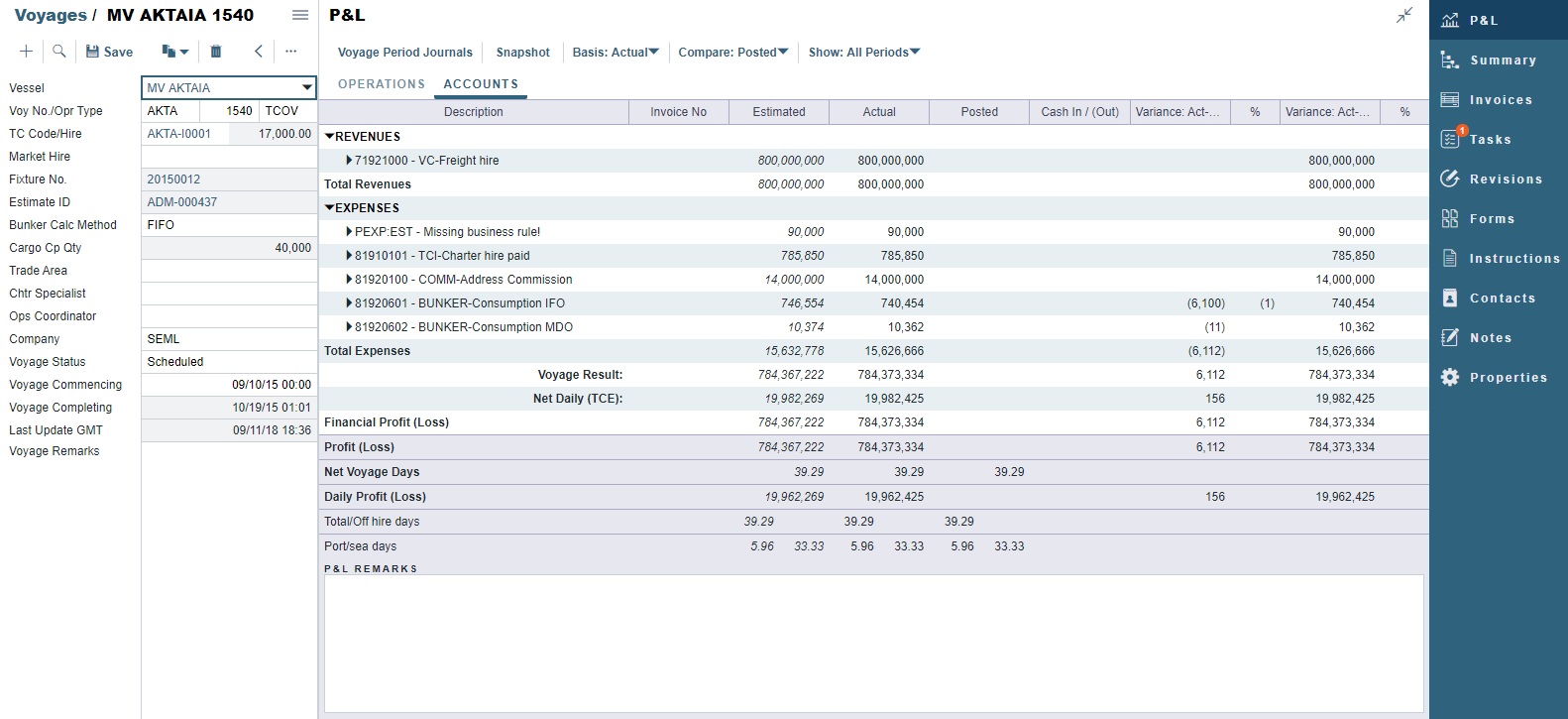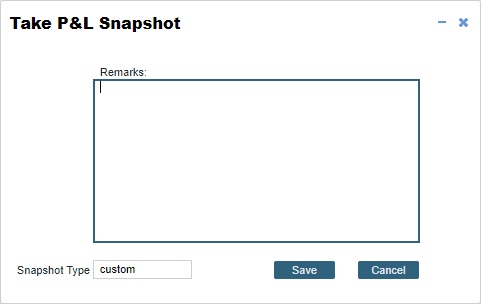IMOS - P&L - Voyage
Home > Operations > P&L - Voyage
🔑 This is a Key Topic, with high value for all users.
You must have the Voyage P&L Summary Module Right selected, under Reports in the Operations module.
On the Voyage Manager, the P&L panel enables you to access detailed Profit and Loss information for financial monitoring, reconciliation, and auditing. It shows Estimated, Actual, Posted, and Cash columns, as well as Variance columns showing the difference and percentages between Actual and Estimated and Actual and Posted. You can use this information, along with the Estimate, to determine reasons for any variances and see how well you estimated or what you might be able to improve.
To open or close the panel, click 

To expand the panel, click 

Views
To select Operations or Accounts view, at the top right of the expanded Voyage P&L, click its button.
In either view, to create Voyage Journal Entries for Vessel Daily Cost (Hire), Voyage Bunker Cost, Bareboat Daily Cost, and TC In/TC Out Bunker Adjustments, click Voyage Period Journals to open Voyage Period Journals.
Operations View (Default)
Operators use this view to see categories of revenues and expenses.

Note: The expanded revenues/expenses will show different format types if users use different Locale languages across the company.
Accounts View
Accounting roles typically use this view to see the name and number of each ledger account affected by the voyage and how costs are allocated to them.

Snapshots
Note: You must have the Revise a Fixed Estimate Module Right selected, under Actions in Chartering.
To save a snapshot of the P&L:
Click Snapshot and then click Take Snapshot or Update Initial Snapshot.

Enter Remarks.
Select a Snapshot Type:
custom or P&L Snapshot Type Name: Saves the snapshot to the database.
exportXml: Creates an XML notification when voypnlsnapshot/exportXml is added to the notificationsIncludeList configuration flag. For more information, see the Messaging Service Manual.
Click Save.
To view a saved snapshot, click 
Snapshot Types
Snapshot types include:
Snapshots you take (custom, P&L Snapshot Type Name, or exportXml); these appear with the date, time, and user.
initial: Depending on the value of configuration flag CFGInitialSnapshotTimeSelect, snapshots are automatically taken when a voyage is either scheduled or commenced. This snapshot is used as the basis for the Estimated column on the Voyage P&L and the estimated values in the Voyage P&L reports (Values will only display if snapshot is taken).
current: Snapshots are automatically taken when a voyage is saved.
closed: Snapshots are automatically taken when a voyage is closed; the date and time are followed by the text Closing.
accrual: Monthly Accruals Snapshots are taken while using the Daily Snapshot method to generate Accruals; the date and time are followed by the text Accrual.
deviation: Snapshots are automatically taken when creating a Deviation Estimate; the date, time, and user are preceded by the text Dev Est.
Estimated, Actual, Posted, Cash, and Variance Columns
Estimated: These figures come from the Estimate that this voyage originated from. If no Estimate exists, these figures are calculated from the initial data in the voyage when it is created.
Actual: When a voyage is scheduled, the estimated revenue and cost items from the Estimate populate the Actual column, being the best knowledge of the voyage result at that time. There may be a difference between estimated and actual P&L even when the voyage is originally scheduled. A difference can arise if changes are made on the Voyage Fixture or on the voyage itself before commencement. A common such case is when the commencing port is different between the Estimate and the voyage. Therefore, different bunker expenses apply.
Until the Voyage Status is set to Completed, all operational updates are reflected in the Actual column, indicating voyage revenue/expense variations based on updated information during the voyage (for example, an FDA, or a change in bunker consumption because of a deviation).
Posted: This column includes only amounts that are posted to the P&L using the Transaction Data Entry form. Although posted proforma port expense invoices appear in the Actual column, they are not included here because the amounts are typically posted to Balance Sheet accounts rather than P&L accounts.
Cash: This column includes payment and receipt transaction amounts against the amounts listed in the Posted column.
Variance:
Act - Est displays the difference between Actual and Estimated.
Act - Est % is calculated as (Act-Est)/Absolute value of Est. This ensures that when Estimated and Actual are both negative, the Variance % is negative when Actual is less than Estimated and positive when Actual is greater than Estimated.
Act - Pst displays the difference between Actual and Posted.
Act - Pst % is calculated as (Act-Pst)/Absolute value of Act. This ensures that when Posted and Actual are both negative, the Variance % is negative when Actual is less than Posted and positive when Actual is greater than Posted.
Snapshot and Period Comparison
For P&L Snapshot comparison, two selection lists include all the snapshots taken of this voyage:
Basis (first column to the right of Estimated): The default value is Actual. When you select a different snapshot:
The Actual column displays the Actual values from the selected Basis snapshot.
For a selection other than Actual, the snapshot's date appears under the column title.
For a snapshot you take, if you add Remarks, they appear in the P&L Remarks field on the Voyage P&L.
Compare (second column to the right of Estimated): The default value is Posted. When you select a different snapshot:
The Posted column displays the Actual values from the selected Compare snapshot.
The Posted column title changes to Compare, with the selected snapshot's short name under it.
For a selection other than Posted, the snapshot's date appears under the column title.
Variance columns display the variance between the snapshots.
If monthly accruals are run for this voyage, the Period selection list includes the months during which the voyage ranges, and All. Selecting a month in this field shows all the Estimated and Actual values prorated until the end of the selected month. The Posted and Cash columns show the full transactions made until that date.
Revenues and Expenses
Items in the list are broken out into Revenues and Expenses, in a tree format. With a configuration flag enabled, Running Costs can be a separate category.
To expand an item to examine it in detail, click the right arrow.
. The calculations appear with the details. When an invoice is created, the Invoice Number appears as a link that you can click to open the invoice; each line item in the invoice is a separate item in the P&L.
To collapse an item again, click the down arrow.
Totals
The following totals can appear at the bottom of the table:
Voyage Result
Net Daily (TCE) = (Net Income − (Total Expenses − (Vessel Expenses + Ballast Bonus + TC In Common Voyage Expenses − Address Commission))) / Voyage Days
Note: TC In Common Voyage Expenses do not include ILOHC or INTHC; these two expenses affect TCE.For Type G (Gas Carrier) vessels, Net Monthly (TCE) appears in addition to Net Daily (TCE).
Profit (Loss)
Market Profit (Loss): Appears if a value is entered in the Market Hire field; note Module Right Edit Market Hire on Voyages with Status Other Than Scheduled.
Net Voyage Days = Total Voyage Days − Off Hire Days − Waiting Days
Note 1: Net Voyage Days is a rounded-up number. To use this number in any calculation, open to the Voyage Itinerary Port/Date tab and then hover over any value in the PDays, SDays, XSD, or TSday (SDays + XSD) column. The exact number appears, including decimals.
Note 2: For continuous Off Hire it is important to exactly match the “To” with the “From” time on each line of the Off Hire screen in order to avoid unwanted Net Daily (TCE) spikes (since "Net Voyage Days" in in the denominator of the Net Daily (TCE) formula above)Daily Profit (Loss)
With Profit Sharing:
Profit Share
Net Voy Profit: Total Voyage Profit minus Profit Share
Net Daily Profit (Loss)
Total/Off hire days
Port/Sea days
With configuration flag CFGShowWaitingCostInVoyagePnL enabled, and if applicable:
Waiting for Laycan
Waiting for Orders
Remarks
To add remarks to the current P&L, edit the P&L Remarks field. These remarks are separate from those entered on Snapshots.
Possible Errors
Missing Business Rule
If the description of one of your items is Missing Business Rule, find the Invoice type (Source) and item (Code), and add the account in the Business Rules. In this case, in Accounts view, the P&L totals display amounts that are red and crossed out.
Uncategorized Adjustments
If you have the wrong account type set up for an item, an Uncategorized Adjustments category appears in Accounts view. For example, this can occur if you have VEXP/VOEXP set to post to a Balance Sheet account and create a miscellaneous expense.
Invariant
Invariants occur when P&L items are incorrectly mapped to the balance sheet or income statement. A value that is red and crossed out on the P&L has an invariant error if, when you hover over it, PNL, Invariant, and Differential values appear.
Reporting P&L Data in the Report Designer
Be sure to save the voyage then refresh the Report Designer report on a regular basis to ensure accurate data is being displayed. Failure to do so will cause inconsistencies and variances to arise between the Voyage P&L and Report Designer data.
